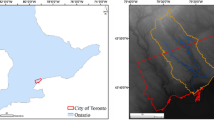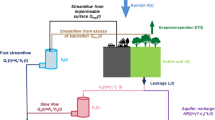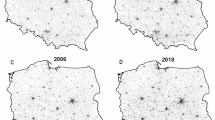Abstract
This study mainly explores effects of urbanization factors on hydrograph parameters. Urbanization impacts of the developing watershed are evaluated based on rainfall–runoff simulations. A total of 51 rainfall–runoff events occurred from 1966 to 2002. Forty of these were calibrated, and effects of urbanization factors on runoff hydrographs resulting from a simple hydrological model were assessed. The block Kriging method was used to estimate the mean rainfall of the Wu-Tu watershed, and its hourly excesses were calculated by using the non-linear programming method. The remaining 11 cases were used to test the established relationships. The calibration and verification results confirm that the integral methods used in this study effectively illustrate the hydrological and geomorphic conditions in complex urbanization processes. Parameter n responds more sensitively than parameter k to increasing impervious areas and population densities. Additionally, parameter n responds more strongly to imperviousness than to population. Therefore, an impervious area is an important reference for analyzing hydrological changes of urbanization in the Wu-Tu watershed.
Similar content being viewed by others
Explore related subjects
Discover the latest articles and news from researchers in related subjects, suggested using machine learning.References
Arnold CLJ, Gibbons CJ (1996) Impervious surface coverage—the emergence of a key environmental indicator. J Am Plann Assoc 62:243–256. doi:10.1080/01944369608975688
Bastin G, Lorent B, Duque C, Gevers M (1984) Optimal estimation of the average rainfall and optimal selection of raingauge locations. Water Resour Res 20:463–470. doi:10.1029/WR020i004p00463
Boyd MJ, Bufill MC, Knee RM (1994) Predicting pervious and impervious storm runoff from urban basins. Hydrol Sci J 39:321–332
Brown RG (1988) Effects of precipitation and land use on storm runoff. Water Resour Bull 24:421–426
Cheng SJ, Wang RY (2002) An approach for evaluating the hydrological effects of urbanization and its application. Hydrol Process 16:1403–1418. doi:10.1002/hyp.350
Cheng SJ, Hsieh HH, Wang YM (2007) Geostatistical interpolation of space–time rainfall on Tamshui River Basin, Taiwan. Hydrol Process 21:3136–3145. doi:10.1002/hyp.6535
Cheng KS, Lin YC, Liou JJ (2008a) Rain-gauge network evaluation and augmentation using geostatistics. Hydrol Process 22:2554–2564. doi:10.1002/hyp.6851
Cheng SJ, Hsieh HH, Lee CF, Wang YM (2008b) The storage potential of different surface coverings for various scale storms on Wu-Tu watershed, Taiwan. Nat Hazards 44:129–146. doi:10.1007/s11069-007-9146-x
Chow VT, Maidment DR, Mays LW (1988) Applied hydrology. McGraw-Hill, New York.
Cuo L, Lettenmaier DP, Mattheussen BV, Storck P, Wiley M (2008) Hydrologic prediction for urban watersheds with the distributed hydrology-soil-vegetation model. Hydrol Process 22:4205–4213. doi:10.1002/hyp.7023
Duan Q, Gupta VK, Sorooshian S (1993) Shuffled complex evolution approach for effective and efficient global minimization. J Optim Theory Appl 76:501–521. doi:10.1007/BF00939380
Ferguson BK, Suckling PW (1990) Changing rainfall–runoff relationships in the urbanizing Peachtree Creek Watershed, Atlanta, Georgia. Water Resour Bull 26:313–322
Franchini M, O’Connell PE (1996) An analysis of the dynamic component of the geomorphologic instantaneous unit hydrograph. J Hydrol (Amst) 175:407–428. doi:10.1016/S0022-1694(96)80018-7
Goovaerts P (2000) Geostatistical approaches for incorporating elevation into the spatial interpolation of rainfall. J Hydrol (Amst) 228:113–129. doi:10.1016/S0022-1694(00)00144-X
Gremillion P, Gonyeau A, Wanielista M (2000) Application of alternative hydrograph separation models to detect changes in flow paths in a watershed undergoing urban development. Hydrol Process 14:1485–1501. doi:10.1002/1099-1085(20000615)14:8<1485::AID-HYP988>3.0.CO;2-1
Hannah DM, Gurnell AM (2001) A conceptual, linear reservoir runoff model to investigate melt season changes in cirque glacier hydrology. J Hydrol (Amst) 246:123–141. doi:10.1016/S0022-1694(01)00364-X
Hollis GE (1975) The effect of urbanization on floods of different recurrence interval. Water Resour Res 11:431–435. doi:10.1029/WR011i003p00431
Hsieh LS, Wang RY (1999) A semi-distributed parallel-type linear reservoir rainfall–runoff model and its application in Taiwan. Hydrol Process 13:1247–1268. doi:10.1002/(SICI)1099-1085(19990615)13:8<1247::AID-HYP807>3.0.CO;2-W
Huang HJ, Cheng SJ, Wen JC, Lee JH (2008a) Effect of growing watershed imperviousness on hydrograph parameters and peak discharge. Hydrol Process 22:2075–2085. doi:10.1002/hyp.6807
Huang SY, Cheng SJ, Wen JC, Lee JH (2008b) Identifying peak–imperviousness–recurrence relationships on a growing-impervious watershed, Taiwan. J Hydrol (Amst) 362:320–336
Hundecha Y, Bardossy A (2004) Modeling of the effect of land use changes on the runoff generation of a river basin through parameter regionalization of a watershed model. J Hydrol (Amst) 292:281–295. doi:10.1016/j.jhydrol.2004.01.002
Junil P, Kang IS, Singh VP (1999) Comparison of simple runoff models used in Korea for small watersheds. Hydrol Process 13:1527–1540. doi:10.1002/(SICI)1099-1085(199907)13:10<1527::AID-HYP804>3.0.CO;2-A
Kang IS, Park JI, Singh VP (1998) Effect of urbanization on runoff characteristics of the On-Cheon Stream Watershed in Pusan, Korea. Hydrol Process 12:351–363. doi:10.1002/(SICI)1099-1085(199802)12:2<351::AID-HYP569>3.0.CO;2-O
Lebel T, Bastin G (1985) Variogram identification by the mean squared interpolation error method with application to hydrologic field. J Hydrol (Amst) 77:31–56. doi:10.1016/0022-1694(85)90196-9
Lee YH, Singh VP (2005) Tank model for sediment yield. Water Resour Manag 19:349–362. doi:10.1007/s11269-005-7998-y
Leopold LB (1991) Lag times for small drainage basins. Catena 18:157–171. doi:10.1016/0341-8162(91)90014-O
Matheussen B, Kirschbaum RL, Goodman IA, O’Donnell GM (2000) Effects of land cover changes on streamflow in the Interior Columbia River Basin (USA and Canada). Hydrol Process 14:867–885. doi:10.1002/(SICI)1099-1085(20000415)14:5<867::AID-HYP975>3.0.CO;2-5
Moon J, Kim JH, Yoo C (2004) Storm-coverage effect on dynamic flood-frequency analysis: empirical data analysis. Hydrol Process 18:159–178. doi:10.1002/hyp.1303
Moscrip AL, Montgomery DR (1997) Urbanization, flood frequency, and salmon abundance in Puget lowland streams. J Am Water Resour Assoc 33:1289–1297. doi:10.1111/j.1752-1688.1997.tb03553.x
Nash JE (1957) The form of the instantaneous unit hydrograph. IAHS Publ 45:112–121
Olivera F, DeFee BB (2007) Urbanization and its effect on runoff in the Whiteoak Bayou watershed, Texas. J Am Water Resour Assoc 43:170–182
Sala M, Inbar M (1992) Some hydrologic effects of urbanization in Catalan Rivers. Catena 19:363–378. doi:10.1016/0341-8162(92)90009-Z
Simmons DL, Reynolds RJ (1982) Effects of urbanization on base flow of selected south-shore streams, Long Island, New York. Water Resour Bull 18:797–805
Singh RB (1998) Land use/cover changes, extreme events and ecohydrological response in the Himalayan region. Hydrol Process 12:2043–2055. doi:10.1002/(SICI)1099-1085(19981030)12:13/14<2043::AID-HYP718>3.0.CO;2-0
Syed KH, Goodrich DC, Myers DE, Sorooshian S (2003) Spatial characteristics of thunderstorm rainfall fields and their relation to runoff. J Hydrol (Amst) 271:1–21. doi:10.1016/S0022-1694(02)00311-6
White LW, Vieux B, Armand D (2002) Surface flow model: inverse problems and predictions. Adv Water Resour 25:317–324. doi:10.1016/S0309-1708(01)00062-8
Yue S, Hashino M (2000) Unit hydrographs to model quick and slow runoff components of streamflow. J Hydrol (Amst) 227:195–206. doi:10.1016/S0022-1694(99)00185-7
Author information
Authors and Affiliations
Corresponding author
Rights and permissions
About this article
Cite this article
Cheng, Sj., Lee, Cf. & Lee, Jh. Effects of Urbanization Factors on Model Parameters. Water Resour Manage 24, 775–794 (2010). https://doi.org/10.1007/s11269-009-9471-9
Received:
Accepted:
Published:
Issue Date:
DOI: https://doi.org/10.1007/s11269-009-9471-9




